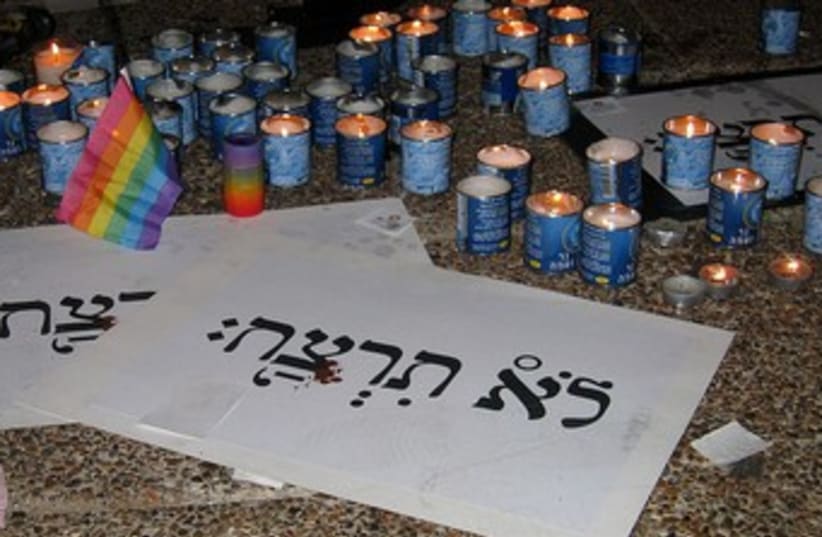A channel 2 report on Monday night called into question the credibility of the key state witness in the Bar Noar killings.The segment on the Uvda television program discussed an earlier infamous case involving Ya’acov Felician – brother of Hagai Felician, who is accused of killing two people at Tel Aviv’s Bar Noar LGBT center in August 2009. Ya’acov allegedly played a role in the October 7, 2006, slaying of Ayal Salhov, a high-level police informant who was killed by a single gunshot to the head in a remote area of the Pardess Katz neighborhood.
Ya’acov’s closest childhood friend is shown on Uvda saying that he told police investigators he knew Ya’acov was involved in the killing of Salhov, but that they did not follow up on his information after determining that he was not trustworthy.
The friend is the state’s key witness regarding the Bar Noar killings, a man upon whom the state has built a significant portion of its case.
Salhov’s murder is a lingering sore spot for Israeli police, an embarrassing affair in which they were unable to protect a state witness from being killed by his associates, even though he had told them repeatedly that he feared that they were onto him and his days were numbered.
In the Uvda program, the question was posed: how can the prosecution and a court trust a witness in the Bar Noar case who the police did not trust in the earlier Salhov case? (It also does not help that the witness embarrassed the state by briefly fleeing protective custody.) True, the prosecution claims that not everything restes on the witness and that it has additional pieces of evidence.
Reportedly, the prosecution obtained an indirect confession from Hagai to a cellmate, who was a police informant.
But confessions to cell-mates who are police informants have often been successfully attacked in the past as being inherently questionable and obtained in misleading circumstances.
Shaul Gonen, the manager of the Bar Noar club, also signed a deal to be a state witness in exchange for immunity regarding the charge that he sexually assaulted a younger relative of Hagai’s – an assault which is said to be the motivation for Hagai allegedly committing the Bar Noar murders.
But because of the serious criminal charge against Gonen and the clear personal conflict between him and the Bar Noar murder, it is uncertain how seriously his testimony will be taken.
Also, even with the confession to the cell-mate and Gonen as a witness, the prosecution does not have any physical evidence connecting Felician to the crime scene or the murder weapon, nor any witnesses placing him at the scene of the crime.
Moreover, if not for the state witness, it is unclear that the police would ever have broken open the case.
Even as the state claims there is additional corroborating evidence, given the importance of the state witness, sources indicate that the prosecution may confront any attack by the defense on its key witness similar to the questions raised by Uvda with a variation on its approach to state witness Shmuel Duchner in the Holyland trial.
Duchner freely admitted lying and exaggerating to the prosecution and to the court (including forging documents) to boost his claims against the Holyland trial defendants.
In many cases such admissions would lead to disqualifying a witness’ entire testimony.
But the prosecution convinced the court that it could split Duchner’s testimony into the true half and the untrue half, carving out the border using its own judgment and with the help of corroborating evidence.
The cell-mate confession, Gonen’s testimony and other evidence may be weak by themselves or if depended on as primary evidence, but the prosecution could argue that when that same evidence is used merely to support the testimony of its main witness, it serves as strong supporting evidence.
Put differently, the prosecution could still triumph if the court views the sum of the imperfect main state witness along with the imperfect supporting testimony as greater than the individual parts when viewed in isolation.
Sources also tried to make the more technical argument that the prosecution and the police are separate organs of the state.
The sources said that the prosecution would not be tied down by the 2006 case, since that case never reached it and it never made its own determination about the state witness’s credibility.
Rather, in the 2006 case, the current state witness was disregarded by police at an early stage, and only the police, not the prosecution, are vulnerable to attack for now trying to use that same witness.
This technical argument may hold little water since if anything the difference between the police and the prosecution is that the prosecution has a stricter standard for accepting evidence and witnesses than the police.
In other words, if even the police rejected the witness’ testimony in 2006, it appears even stranger that the prosecution would rely on that same witness to testify now.
It is probably going too far to say that the Uvda program torpedoed the prosecution’s Bar Noar case against Hagai.
But having to prove a case with complex explanations is always more difficult.
With all of the prosecution’s complex ways of explaining itself and relying on a witness who was once considered untrustworthy, the allegations from the program certainly showed the prosecution’s case to be much more of an uphill battle.
Ben Hartman contributed to this story.
